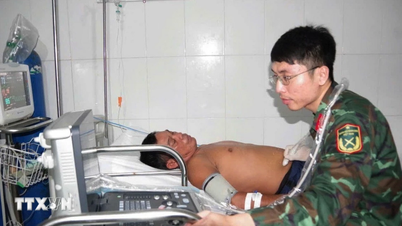Diabetic shock, also known as severe hypoglycemia, is a condition in which blood glucose levels drop so low that they affect the normal functioning of the brain and body, according to the medical information website Medicine Net (USA).

Diabetic shock causes the patient to tremble and have a rapid heartbeat.
PHOTO: AI
Hypoglycemia is usually when blood sugar levels fall below 70 mg/dL. At this point, symptoms of hypoglycemia are mild. However, if blood sugar continues to fall below 60 mg/dL, or even below 50 mg/dL, it can cause diabetic shock.
Normally, blood glucose is the main source of energy for the body, especially the brain. When there is insufficient glucose, the brain does not receive the energy it needs to function, leading to cognitive and neurological disorders.
The main cause of diabetic shock is often due to taking insulin or other diabetes medications, combined with factors such as inadequate diet, over-exercise, drinking alcohol or accompanying diseases.
When blood sugar drops suddenly, the body reacts by activating hormones such as adrenaline to increase blood sugar, causing symptoms such as sweating, trembling, and anxiety. If left untreated, diabetic shock can progress to serious, even life-threatening conditions.
Diabetic shock is considered a medical emergency because the brain is very sensitive to glucose deprivation. When there is not enough glucose to function, nerve cells begin to be damaged. If this condition persists without treatment, permanent brain damage can occur or the person may fall into a coma.
In addition, diabetic shock also causes cardiovascular disorders such as irregular heartbeat, low blood pressure, increased risk of stroke or other serious complications.
Signs of diabetic shock
Common signs of diabetic shock include shaking, cold sweats, sudden hunger, headache, dizziness, fatigue, weakness, and rapid heart rate. These symptoms can appear quickly, within minutes.
When detecting signs of hypoglycemia, relatives need to quickly handle to raise blood sugar to a safe level. The patient needs to eat or drink foods containing fast sugar, such as taking about 15-20 grams of simple carbohydrates such as carbonated soft drinks, fruit juice, candy, honey or glucose tablets. Then wait about 15 minutes and measure blood sugar again. If it is still low, continue to add more sugar.
If the patient is unconscious, do not give them food or drink to avoid the risk of choking. Instead, relatives should take the patient to the hospital immediately, according to Medicine Net .
Source: https://thanhnien.vn/soc-tieu-duong-nguy-hiem-ra-sao-18525060613341195.htm

























































































![[OCOP REVIEW] Tu Duyen Syrup - The essence of herbs from the mountains and forests of Nhu Thanh](https://vphoto.vietnam.vn/thumb/402x226/vietnam/resource/IMAGE/2025/6/5/58ca32fce4ec44039e444fbfae7e75ec)






Comment (0)